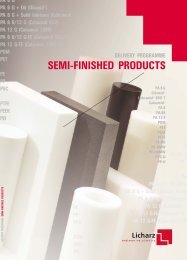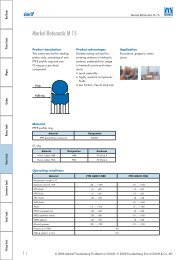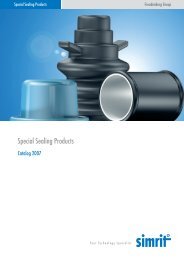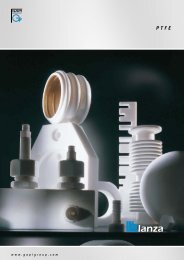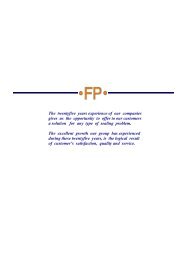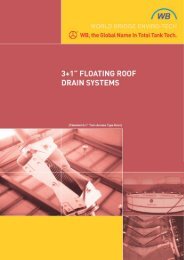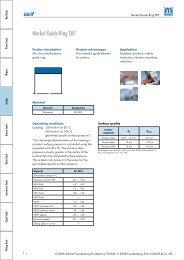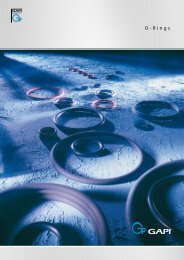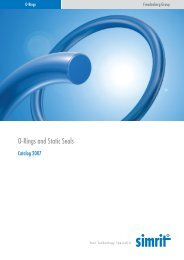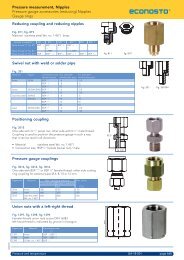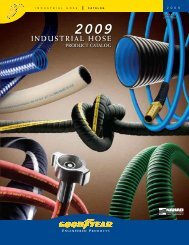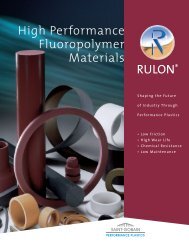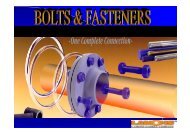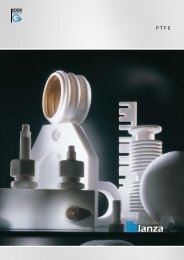Oleodinamica/Pneumatica Hydraulic/ Pneumatic
Oleodinamica/Pneumatica Hydraulic/ Pneumatic
Oleodinamica/Pneumatica Hydraulic/ Pneumatic
You also want an ePaper? Increase the reach of your titles
YUMPU automatically turns print PDFs into web optimized ePapers that Google loves.
KDSP<br />
TEnuTA PISTOnE COMPATTA TIPO KDSP<br />
Descrizione<br />
La guarnizione KDSP nasce per tenuta pistone con<br />
sedi intercambiabili ISO 6547.<br />
E' composta da soli tre elementi: quello centrale<br />
in poliuretano (che ha la funzione di tenuta) e due<br />
guide laterali in poliacetalica rinforzata vetro.<br />
Questo sistema permette di eliminare i supporti<br />
antiestrusione, in quanto l'elemento centrale col suo<br />
alto modulo elastico ha una durezza superiore alla<br />
gomma nitrilica NBR.<br />
L’attrito di primo distacco ed in esercizio si mantiene<br />
basso per la particolare geometria della guarnizione.<br />
Dati tecnici<br />
Pressione: da 0 a 300 Bar con punte fino a 400<br />
Bar a 60° C.<br />
Velocità: 0,8 m/s<br />
Temperatura: da – 30° C a + 100 ° C<br />
Fluidi: oli a base minerale<br />
(vedi TABELLA I pagg. 10-11)<br />
Materiale<br />
I materiali utilizzati per la costruzione di questo tipo<br />
di guarnizione sono i seguenti:<br />
- l'elemento centrale in poliuretano di durezza 93 Sh<br />
A Codice materiale tipo C0<br />
- gli elementi laterali in poliacetalica caricata vetro<br />
(POM)<br />
Codice materiale: CX<br />
Montaggio<br />
Il montaggio di questa tenuta può essere eseguito<br />
sia in cava chiusa su pistone monoblocco, sia in cava<br />
aperta su pistone in due pezzi.<br />
E' necessario che il pistone non presenti bave<br />
di lavorazione meccanica che danneggerebbero<br />
l'elemento di tenuta durante il montaggio.<br />
<strong>Oleodinamica</strong> & <strong><strong>Pneumatic</strong>a</strong><br />
COMPACT PISTOn SEAL TyPE KDSP<br />
Description<br />
The KDSP seal is designed to be a piston seal with<br />
interchangeable seats ISO 6547.<br />
It consists of only three elements: a polyurethane<br />
seal at the centre and two side wiper rings in glassfilled<br />
polyacetal resin.<br />
This system does away with anti-extrusion supports,<br />
given the high modulus of elasticity of the central<br />
element and the higher hardness when compared to<br />
nitrilic rubber.<br />
Abrasion is also considerably reduced, thus<br />
facilitating the construction of the seat and bores<br />
and therefore extending the service life of the seal.<br />
Technical data<br />
Pressure: from 0 to 300 Bar with peaks up to<br />
400 Bar at 60° C.<br />
Speed: 0.8 m/s<br />
Temperature: from – 30° C to + 100 ° C<br />
Fluids: mineral oils (see TABLE I, pages 10-11)<br />
Material<br />
The materials used for the construction of this seal<br />
type are as follows:<br />
- polyurethane for the central element, hardness 93<br />
Sh A, compound reference C0<br />
- glass-filled polyacetal resin (POM) for the side<br />
elements<br />
Compound reference: CX<br />
Assembly<br />
This seal can be assembled both in closed groove on<br />
a monobloc piston and in open groove on a two-part<br />
piston.<br />
The piston must not have machining scores which<br />
might damage the sealing during the installation.



